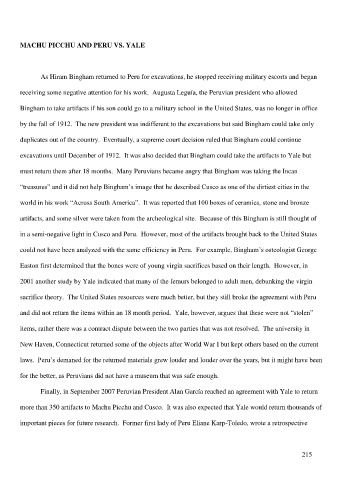Page 215 - ce_cusco_2019
P. 215
MACHU PICCHU AND PERU VS. YALE
As Hiram Bingham returned to Peru for excavations, he stopped receiving military escorts and began
receiving some negative attention for his work. Augusta Leguía, the Peruvian president who allowed
Bingham to take artifacts if his son could go to a military school in the United States, was no longer in office
by the fall of 1912. The new president was indifferent to the excavations but said Bingham could take only
duplicates out of the country. Eventually, a supreme court decision ruled that Bingham could continue
excavations until December of 1912. It was also decided that Bingham could take the artifacts to Yale but
must return them after 18 months. Many Peruvians became angry that Bingham was taking the Incan
“treasures” and it did not help Bingham’s image that he described Cusco as one of the dirtiest cities in the
world in his work “Across South America”. It was reported that 100 boxes of ceramics, stone and bronze
artifacts, and some silver were taken from the archeological site. Because of this Bingham is still thought of
in a semi-negative light in Cusco and Peru. However, most of the artifacts brought back to the United States
could not have been analyzed with the same efficiency in Peru. For example, Bingham’s osteologist George
Easton first determined that the bones were of young virgin sacrifices based on their length. However, in
2001 another study by Yale indicated that many of the femurs belonged to adult men, debunking the virgin
sacrifice theory. The United States resources were much better, but they still broke the agreement with Peru
and did not return the items within an 18 month period. Yale, however, argues that these were not “stolen”
items, rather there was a contract dispute between the two parties that was not resolved. The university in
New Haven, Connecticut returned some of the objects after World War I but kept others based on the current
laws. Peru’s demaned for the returned materials grew louder and louder over the years, but it might have been
for the better, as Peruvians did not have a museum that was safe enough.
Finally, in September 2007 Peruvian President Alan García reached an agreement with Yale to return
more than 350 artifacts to Machu Picchu and Cusco. It was also expected that Yale would return thousands of
important pieces for future research. Former first lady of Peru Eliane Karp-Toledo, wrote a retrospective
215

